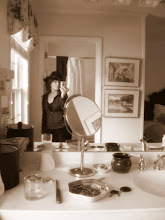Walking through The Show with the Artist
Trudy Babchak and I talked about her paintings a little as
we walked around The Rouse Company Foundation Gallery, yesterday, January 27. Her show will be featured here at Howard
Community College until March 17,
and a reception held on February 13, from 5
to 7 p.m.
Afterward, I asked
whether her paintings in the show seemed more connected thematically or visually.
Of course, I already had an opinion.
The connection between her paintings is the type: Figurative Art. Trudy paints
the figure in solemn isolation or in pairs, or in groups, and sometimes almost
as a frieze, or even floating. All figures—girls, boys, women, men, all ages in
life and displaying distinct moods through form and color.
Role as Viewer: I didn’t
write much down, because, in the long run, she told me very clearly that she wants
the viewer to consider the art itself, without having to put it in words. I thought about it, and totally agree with this
artist. For the most part, I feel the
same way about my poetry; I don’t want to have to explain it. If the artist or writer or musician does all
the work, then what’s the point? And we all know that some pieces will be more
emotional to some, than to others. Now, I do know about and have previously witnessed a
background of pain and loss here, both familial and historical, and have
written about it in other features on Trudy’s art. Losing someone close to us in the horrors of
war or other violence serves to underscore a sad and repetitive human theme
across the ages.
Specifically Trudy: Whether deliciously dancing on ground, perhaps in the clouds, or somewhere above them, to an irony-filled gloss on women in society, to shapely pin-up girls who are shamelessly teasing, Trudy uses broad strokes, impasto, collage, and sometimes, dribbles of paint that look almost like blood, whether that is her intention or not, making a painting even more powerful.
 In a painting that she
titles “Exposed,” one naked woman stands helplessly in a row of suits (men) in
a kind of simple line up. I found this to be possibly the most compelling
societal comment in the show. With their
backs to us, the players seem innocuous enough, but, of course, the statement
is beyond verbalization. I sucked in my breath at the abstracted honesty of her
painting.
In a painting that she
titles “Exposed,” one naked woman stands helplessly in a row of suits (men) in
a kind of simple line up. I found this to be possibly the most compelling
societal comment in the show. With their
backs to us, the players seem innocuous enough, but, of course, the statement
is beyond verbalization. I sucked in my breath at the abstracted honesty of her
painting.The paintings by Trudy Babchak that always stun me to silence, however, are of her family—quiet, flatly produced portraits on doors, some with red backgrounds—of those lost in the Holocaust, or survivors blunted by loss. They are huge paintings, and I find the details often just as powerful as the whole: For example, pairs of high heels worn by Aunts in the family lost to war; or a face behind a window, imprisoned, that seemingly disintegrates as we look at it.
Some of her work is
difficult to view and think about (easy to feel) because it comes back at
you with such immediacy. We reflect that those in power can prey on and
destroy, both physically and spiritually, those who are
vulnerable. Human beings repeat and
repeat the violence toward one another, and one has to wonder if our penchant
for fear, hate, envy and rapaciousness will ever go away, or be transformed. Trudy Babchak’s paintings are neither identified by title nor
theme within this show, so the viewer will be able to pay close attention to
their dynamism, their raw power. I love
her dancing women, partly because dance and joy in dancing, have been part of
my life, and my daughter’s life in particular.
Most of Trudy Babchak’s paintings are acrylic, some oil, and
although the paintings vary in size, they are connected through motion and
emotion, exactly what she named her show. Also, these paintings are displayed
in a way that lends itself to her art. Any themes that may have initially been
grouped together are not here. The viewer literally moves from joy to
questioning, back to joy, to sadness, even despair…round and round. And that is
indicative of the life experience. Don’t
miss this one. I plan to go back again, if I can.
By Kay Weeks
January 28, 2013 and posted here on February 7, 2013
hocoblogs@@@
hocoblogs@@@









No comments:
Post a Comment